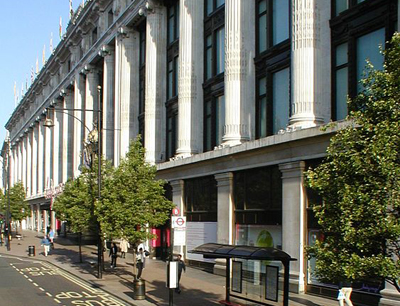The upmarket department store chain John Lewis traces its origins back to 1864 when the man himself opened a drapers at 132 Oxford Street (later renumbered, it’s the site of the current store).
Originally from Somerset and brought up by an aunt after he was orphaned at a young age, Lewis served as an apprentice to a linen draper in Wells as a teenager before he moved to London to work as salesman for an Oxford Street draper, eventually becoming a silk buyer. He apparently turned down offer of partnership in that business, deciding instead to put out his own shingle.
Lewis slowly expanded his business into neighbouring properties and diversified into a growing range of goods – everything from clothing to furniture to kitchen china. By 1895 he had rebuilt his original shop, which now had fronts on Oxford and Holles Streets, into a multi storey department store with retail showrooms as well as a warehouse and a restaurant for customers.
More than 40 years after he opened his first shop in London, in 1905 Lewis acquired Peter Jones in Sloane Square. His sons, John Spedan Lewis and Oswald, became partners in the business in 1907. Oswald was later bought out but John, particularly while convalescing following a riding accident, began to think about how he could improve staff wages and working conditions.
However, his new ideas led to conflict with his father (known to be a tough employer) and so, in 1914, Spedan Lewis took over total control of the Peter Jones business in exchange for no longer taking any part in the Oxford Street store. Instead, turning his attention to the Sloane Square business, he introduced a profit-sharing scheme for employees as well as a representative staff council and other initiatives including the introduction of the weekly in-house magazine, The Gazette.
In 1924, Spedan Lewis was reconciled with his father and so it was that following his father’s death in 1928, he became sole owner of both businesses, bringing them together into a single entity. The famous motto – “Never Knowingly Undersold” – has apparently been in use in the Peter Jones store since it was introduced by Spedan Lewis in 1925.
In 1929, he created the John Lewis Partnership Ltd and while he continued to have practical control of the business, his reforms meant profits were distributed among employees. Twenty-one years later, in 1950, he signed settlement which saw the partnership become the property of the employees.
In 1933, the partnership purchased its first store outside London in Nottingham and it is now regarded as the largest department store retailer in the UK with 46 John Lewis shops including 32 department stores. It also owns the Waitrose supermarket chain.
The flagship Oxford Street store was almost completely destroyed during World War II. The present premises, which features a roof garden, opened in 1961. It features a famous (now Grade II*-listed) artwork – Barbara Hepworth’s Winged Figure – on the Holles Street facade near the corner with Oxford Street.
In 2008 this store was awarded a Royal Warrant from Queen Elizabeth II as “suppliers of haberdashery and household goods”.
This is the final in our current Wednesday series. We’ll be starting a new series shortly.
PICTURE: James Petts/Wikipedia/CC BY-SA 2.0





 In 1849, to capitalise on trade to the upcoming Great Exhibition in Hyde Park in 1851, he took over a small shop on the site of the current store – initially with just two assistants and a messenger boy. In 1861 his son, the similarly-named Charles Digby Harrods, took over the business and by 1880, the store was employing more than 100 people offering customers everything from medicines and perfumes to clothing and food and already attracting the wealthy customers it would become known for.
In 1849, to capitalise on trade to the upcoming Great Exhibition in Hyde Park in 1851, he took over a small shop on the site of the current store – initially with just two assistants and a messenger boy. In 1861 his son, the similarly-named Charles Digby Harrods, took over the business and by 1880, the store was employing more than 100 people offering customers everything from medicines and perfumes to clothing and food and already attracting the wealthy customers it would become known for.



